外文翻译--中国的知识产权保护与外国的直接投资
- 格式:docx
- 大小:288.68 KB
- 文档页数:10
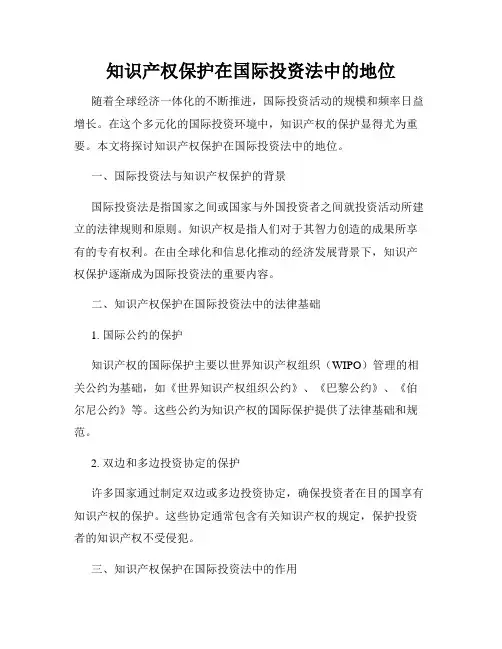
知识产权保护在国际投资法中的地位随着全球经济一体化的不断推进,国际投资活动的规模和频率日益增长。
在这个多元化的国际投资环境中,知识产权的保护显得尤为重要。
本文将探讨知识产权保护在国际投资法中的地位。
一、国际投资法与知识产权保护的背景国际投资法是指国家之间或国家与外国投资者之间就投资活动所建立的法律规则和原则。
知识产权是指人们对于其智力创造的成果所享有的专有权利。
在由全球化和信息化推动的经济发展背景下,知识产权保护逐渐成为国际投资法的重要内容。
二、知识产权保护在国际投资法中的法律基础1. 国际公约的保护知识产权的国际保护主要以世界知识产权组织(WIPO)管理的相关公约为基础,如《世界知识产权组织公约》、《巴黎公约》、《伯尔尼公约》等。
这些公约为知识产权的国际保护提供了法律基础和规范。
2. 双边和多边投资协定的保护许多国家通过制定双边或多边投资协定,确保投资者在目的国享有知识产权的保护。
这些协定通常包含有关知识产权的规定,保护投资者的知识产权不受侵犯。
三、知识产权保护在国际投资法中的作用1. 创新推动经济增长知识产权保护有利于鼓励创新活动,促进科技进步和经济增长。
投资者在知识产权受到保护的国家更愿意在该国进行投资和技术转让,从而带动当地创新和经济发展。
2. 吸引外国直接投资知识产权保护成为吸引外国直接投资的重要因素之一。
投资者看重知识产权在投资回报中的价值,只有在知识产权得到有效保护的国家才会愿意进行投资。
3. 解决知识产权争端国际投资法的机制可以用于解决涉及知识产权的争端。
投资者可以通过国际仲裁机构等途径维护其知识产权权益,确保自身在投资过程中不受不公平待遇。
四、知识产权保护在国际投资法中的挑战1. 不同法律体系的差异不同国家对于知识产权的保护标准和方法存在差异,这给投资者在跨国投资中的知识产权保护带来一定的挑战。
国际投资法需要通过协商和共识,解决跨国知识产权保护的问题。
2. 法律执行的问题知识产权保护在国际投资法中虽然有一定的法律基础,但法律执行仍然面临一些挑战。
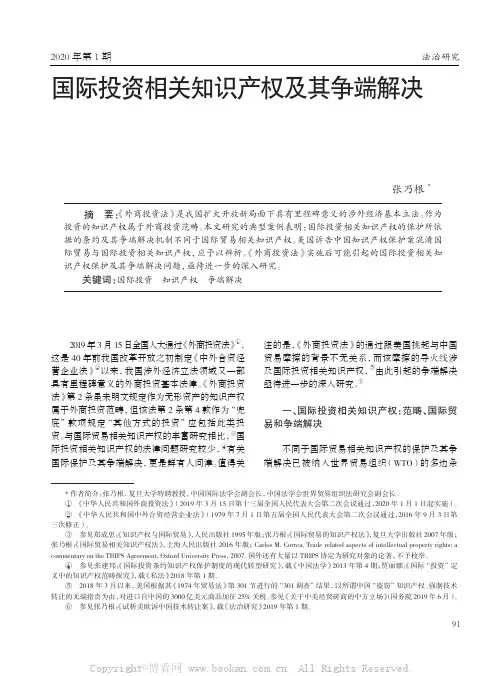
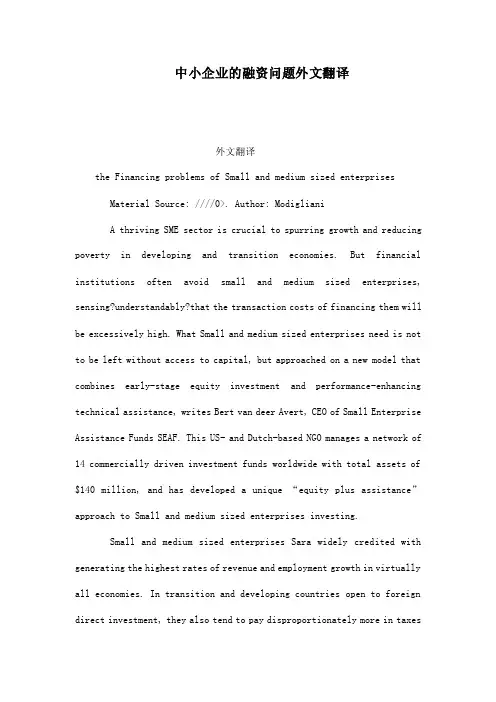
中小企业的融资问题外文翻译外文翻译the Financing problems of Small and medium sized enterprisesMaterial Source: ////0>. Author: ModiglianiA thriving SME sector is crucial to spurring growth and reducing poverty in developing and transition economies. But financial institutions often avoid small and medium sized enterprises, sensing?understandably?that the transaction costs of financing them will be excessively high. What Small and medium sized enterprises need is not to be left without access to capital, but approached on a new model that combines early-stage equity investment and performance-enhancing technical assistance, writes Bert van deer Avert, CEO of Small Enterprise Assistance Funds SEAF. This US- and Dutch-based NGO manages a network of 14 commercially driven investment funds worldwide with total assets of $140 million, and has developed a unique “equity plus assistance” approach to Small and medium sized enterprises investing.Small and medium sized enterprises Sara widely credited with generating the highest rates of revenue and employment growth in virtually all economies. In transition and developing countries open to foreign direct investment, they also tend to pay disproportionately more in taxesand social security contributions than either their larger and smaller counterparts. Larger enterprises, especially multinationals, often find a way to reduce their tax obligations through transfer pricing, royalty payments, and negotiated tax holidays. Microenterprises, on the other hand, often fall in the informal sector, neither paying taxes nor making social security contributions.Yet if Small and medium sized enterprises constitute a critical dimension of growth and development and are often well positioned to achieve high revenue and profit growth, why have private and public financing institutions alike tended to avoid investing in them?The reasons are multiple and, for the most part, understandable. For private investors, the amount of work required to invest relatively small sums into several SMEs seems unattractive compared to the work needed to support fewer investments in larger companies. Moreover, investing in local Small and medium sized enterprises also often involves working with entrepreneurs who are less familiar with conventional financing relationships, business practices, and the English language than principals of larger firms. Accordingly, most private capital would much prefer to invest in a few large-asset There are broader issues to be considered as well, including the lack of transparency in local legal systems and governments that make investing in these countries difficult at best. enterprises in fields such as pharmaceuticals,telecommunications or privatized industry rather than in smaller companies with relatively few assets, low capitalization and a perceived greater vulnerability to market conditions. Public development institutions can also encounter high administrative costs in making small and medium sized enterprises investments. These can be coupled with perceptions that local Small and medium sized enterprises entrepreneurs may not be trustworthy, and that working with them might bring fewer visibly “developmental” benefits than targeting more poverty-focused fields such as microfinance Local commercial banks too are often biased in favor of large corporate borrowers with considerable assets. This has meant that even the lines of credit local banks receive from development institutions for on-lending to Small and medium sized enterprises are often under-utilized. Small and medium sized enterprises entrepreneurs’ lack of experience in accounting and other areas of financial documentation make it difficult for banks or other potential sources to assess their creditworthiness and cash flows, again hindering the provision of financing. Combined, these factors have largely left what should be the most dynamic sector of the economy in developing countries lacking the capital it needs to realize its potential.SEAF believes that the investment levels it takes, coupled with its focused efforts on increase value after investments, and allows it to invest at relatively attractive multiples. This offers an array ofpotential exit possibilities. By contrast, many conventional Emerging market private equity investors have had disappointing records in achieving exits over the last four years. SEAF’s approach to early-stage investing in SMEs thus may one day be seen as one of the more appropriate means of investing in developing countries. In the meantime, SEAF is achieving its developmental objectives by rapidly increasing the revenues, productivity, and employment growth of its investee Small and medium sized enterprises.The financial sector infrastructure will need to change to accommodate the substantial financing requirements of new activities and industries. Going forward, while financial institutions would need to transform to remain innovative and responsive to demands of their customers, efforts need to be directed to facilitate financing by non-banks for high-risk ventures. These include financing for knowledge-intensive and technology-intensive start-up enterprises where only ideas intangible collateral are principal assets. As such, these knowledge-intensive and technology-intensive enterprises will need alternative forms of financing to complement traditional financing sources. These alternative modes of financing include among others, venture capital and credit enhancements such as financial guarantee insurance and agriculture insurance.The financial infrastructure that supports Small and medium sizedenterprises in Serbia is undeveloped. Up to now, small and medium sized enterprises and entrepreneurs have financed their operations out of their own resources because financial markets in Serbia were isolated and lacked the support of international financial institutions. The local financial sector in the former Yugoslavia was designed to support large scale, socially owned enterprises ? otherwise known as the “Pillars of Development.” B anks, especially large-scale socially owned banks, had a redistributive function imposed on them by the state, and they dealt solely with large-scale, socially owned enterprises. In addition, the Fund for Development of the Republic of Serbia disbursed its funds to the same target group. Capacity to repay the banks or the Fund was not a criterion for credit approval.Economists have not always fully appreciated the importance of a healthy financial system for economic growth or the role of financial conditions in short-term economic dynamicsAs a matter of intellectual history, the reason is not difficult to understandDuring the first few decades after World War II, economic theorists emphasized the development of general equilibrium models of the economy with complete markets; that is, in their analyses, economists generally abstracted from market "frictions" such as imperfect information or transaction costsBut without such frictions, financial markets have little reason to existFor example, with complete markets and if we ignore taxes, we know that whether acorporation finances itself by debt or equity is irrelevant the Modigliani-Miller theorem.The former economic and political system did not support the development of financial instruments for Small and medium sized enterprises. Cooperation with SMEs focused on a few selected companies, while sole traders were almost completely excluded from credit transactions with the banking sector. SME owners and citizens completely lost their trust in the banks and channeled their savings into the grey economy, to banks abroad, or kept their savings at home. Only payments effected through the National Payment Bureau functioned properly for Small and medium sized enterprises.译文中小企业的融资问题资源来源:////. 作者:詹姆斯?沃尔芬森中小企业的蓬勃发展对促进经济增长,减少发展中国家的贫穷和经济转型具有重要意义。
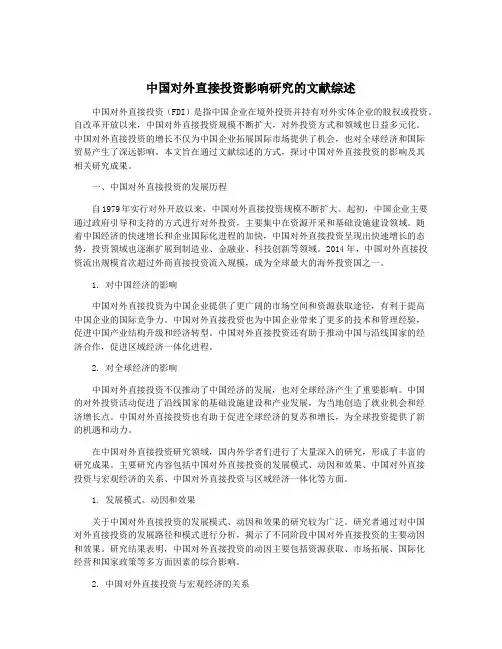
中国对外直接投资影响研究的文献综述中国对外直接投资(FDI)是指中国企业在境外投资并持有对外实体企业的股权或投资。
自改革开放以来,中国对外直接投资规模不断扩大,对外投资方式和领域也日益多元化。
中国对外直接投资的增长不仅为中国企业拓展国际市场提供了机会,也对全球经济和国际贸易产生了深远影响。
本文旨在通过文献综述的方式,探讨中国对外直接投资的影响及其相关研究成果。
一、中国对外直接投资的发展历程自1979年实行对外开放以来,中国对外直接投资规模不断扩大。
起初,中国企业主要通过政府引导和支持的方式进行对外投资,主要集中在资源开采和基础设施建设领域。
随着中国经济的快速增长和企业国际化进程的加快,中国对外直接投资呈现出快速增长的态势,投资领域也逐渐扩展到制造业、金融业、科技创新等领域。
2014年,中国对外直接投资流出规模首次超过外商直接投资流入规模,成为全球最大的海外投资国之一。
1. 对中国经济的影响中国对外直接投资为中国企业提供了更广阔的市场空间和资源获取途径,有利于提高中国企业的国际竞争力。
中国对外直接投资也为中国企业带来了更多的技术和管理经验,促进中国产业结构升级和经济转型。
中国对外直接投资还有助于推动中国与沿线国家的经济合作,促进区域经济一体化进程。
2. 对全球经济的影响中国对外直接投资不仅推动了中国经济的发展,也对全球经济产生了重要影响。
中国的对外投资活动促进了沿线国家的基础设施建设和产业发展,为当地创造了就业机会和经济增长点。
中国对外直接投资也有助于促进全球经济的复苏和增长,为全球投资提供了新的机遇和动力。
在中国对外直接投资研究领域,国内外学者们进行了大量深入的研究,形成了丰富的研究成果。
主要研究内容包括中国对外直接投资的发展模式、动因和效果、中国对外直接投资与宏观经济的关系、中国对外直接投资与区域经济一体化等方面。
1. 发展模式、动因和效果关于中国对外直接投资的发展模式、动因和效果的研究较为广泛。
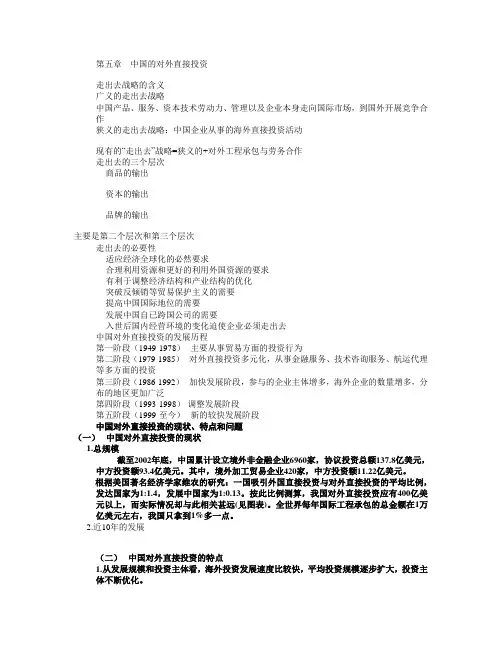
第五章中国的对外直接投资走出去战略的含义广义的走出去战略中国产品、服务、资本技术劳动力、管理以及企业本身走向国际市场,到国外开展竞争合作狭义的走出去战略:中国企业从事的海外直接投资活动现有的“走出去”战略=狭义的+对外工程承包与劳务合作走出去的三个层次商品的输出资本的输出品牌的输出主要是第二个层次和第三个层次走出去的必要性适应经济全球化的必然要求合理利用资源和更好的利用外国资源的要求有利于调整经济结构和产业结构的优化突破反倾销等贸易保护主义的需要提高中国国际地位的需要发展中国自已跨国公司的需要入世后国内经营环境的变化迫使企业必须走出去中国对外直接投资的发展历程第一阶段(1949-1978)--主要从事贸易方面的投资行为第二阶段(1979-1985)--对外直接投资多元化,从事金融服务、技术咨询服务、航运代理等多方面的投资第三阶段(1986-1992)--加快发展阶段,参与的企业主体增多,海外企业的数量增多,分布的地区更加广泛第四阶段(1993-1998)-调整发展阶段第五阶段(1999-至今)--新的较快发展阶段中国对外直接投资的现状、特点和问题(一)中国对外直接投资的现状1.总规模截至2002年底,中国累计设立境外非金融企业6960家,协议投资总额137.8亿美元,中方投资额93.4亿美元。
其中,境外加工贸易企业420家,中方投资额11.22亿美元。
根据美国著名经济学家维农的研究:一国吸引外国直接投资与对外直接投资的平均比例,发达国家为1:1.4,发展中国家为1:0.13。
按此比例测算,我国对外直接投资应有400亿美元以上,而实际情况却与此相关甚远(见图表)。
全世界每年国际工程承包的总金额在1万亿美元左右,我国只拿到1%多一点。
2.近10年的发展(二)中国对外直接投资的特点1.从发展规模和投资主体看,海外投资发展速度比较快,平均投资规模逐步扩大,投资主体不断优化。
一是外贸专业公司和大型贸易集团.二是生产性企业或企业集团.三是大型金融保险、多功能服务公司.四是中小型企业.2.从分部地区看,海外投资企业多集中于我国港澳地区和经济发达的地区,但近年来呈现多元化趋势3. 从行业分布来看,投资领域重点与一般相结合,分布较广。
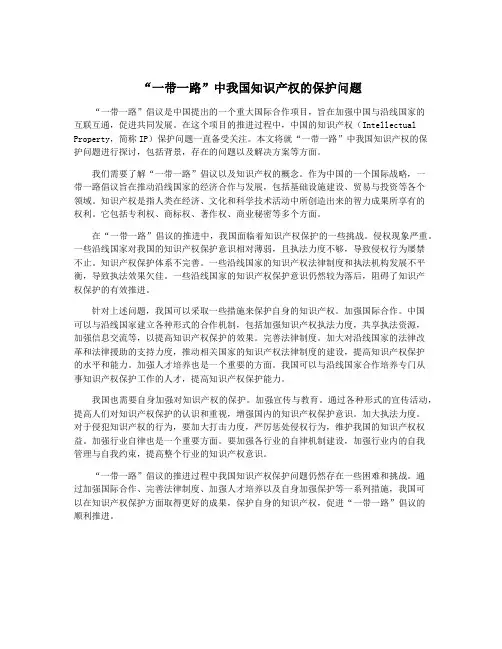
“一带一路”中我国知识产权的保护问题“一带一路”倡议是中国提出的一个重大国际合作项目,旨在加强中国与沿线国家的互联互通,促进共同发展。
在这个项目的推进过程中,中国的知识产权(Intellectual Property,简称IP)保护问题一直备受关注。
本文将就“一带一路”中我国知识产权的保护问题进行探讨,包括背景,存在的问题以及解决方案等方面。
我们需要了解“一带一路”倡议以及知识产权的概念。
作为中国的一个国际战略,一带一路倡议旨在推动沿线国家的经济合作与发展,包括基础设施建设、贸易与投资等各个领域。
知识产权是指人类在经济、文化和科学技术活动中所创造出来的智力成果所享有的权利。
它包括专利权、商标权、著作权、商业秘密等多个方面。
在“一带一路”倡议的推进中,我国面临着知识产权保护的一些挑战。
侵权现象严重。
一些沿线国家对我国的知识产权保护意识相对薄弱,且执法力度不够,导致侵权行为屡禁不止。
知识产权保护体系不完善。
一些沿线国家的知识产权法律制度和执法机构发展不平衡,导致执法效果欠佳。
一些沿线国家的知识产权保护意识仍然较为落后,阻碍了知识产权保护的有效推进。
针对上述问题,我国可以采取一些措施来保护自身的知识产权。
加强国际合作。
中国可以与沿线国家建立各种形式的合作机制,包括加强知识产权执法力度,共享执法资源,加强信息交流等,以提高知识产权保护的效果。
完善法律制度。
加大对沿线国家的法律改革和法律援助的支持力度,推动相关国家的知识产权法律制度的建设,提高知识产权保护的水平和能力。
加强人才培养也是一个重要的方面。
我国可以与沿线国家合作培养专门从事知识产权保护工作的人才,提高知识产权保护能力。
我国也需要自身加强对知识产权的保护。
加强宣传与教育。
通过各种形式的宣传活动,提高人们对知识产权保护的认识和重视,增强国内的知识产权保护意识。
加大执法力度。
对于侵犯知识产权的行为,要加大打击力度,严厉惩处侵权行为,维护我国的知识产权权益。
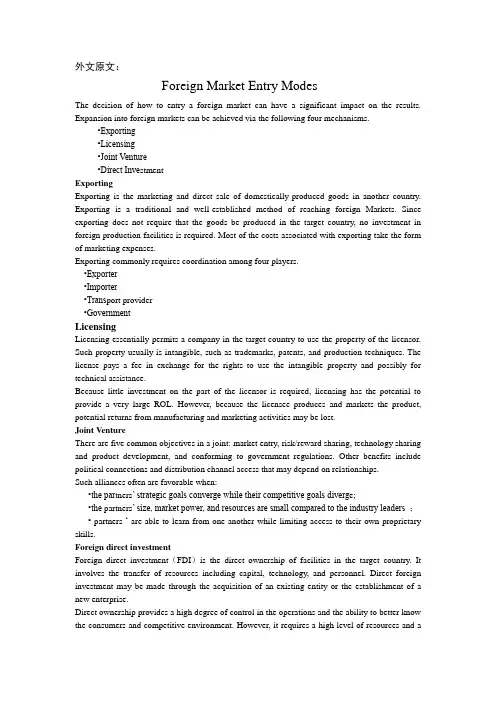
外文原文:Foreign Market Entry ModesThe decision of how to entry a foreign market can have a significant impact on the results. Expansion into foreign markets can be achieved via the following four mechanisms.•Exporting•Licensing•Joint Venture•Direct Inve stmentExportingExporting is the marketing and direct sale of domestically-produced goods in another country. Exporting is a traditional and well-established method of reaching foreign Markets. Since exporting does not require that the goods be produced in the target country, no investment in foreign production facilities is required. Most of the costs associated with exporting take the form of marketing expenses.Exporting commonly requires coordination among four players.•Exporter•Importer•Trans port provider•GovernmentLicensingLicensing essentially permits a company in the target country to use the property of the licensor. Such property usually is intangible, such as trademarks, patents, and production techniques. The license pays a fee in exchange for the rights to use the intangible property and possibly for technical assistance.Because little investment on the part of the licensor is required, licensing has the potential to provide a very large ROL. However, because the licensee produces and markets the product, potential returns from manufacturing and marketing activities may be lost.Joint VentureThere are five common objectives in a joint: market entry, risk/reward sharing, technology sharing and product development, and conforming to government regulations. Other benefits include political connections and distribution channel access that may depend on relationships.Such alliances often are favorable when:•the par tners’ strategic goals converge while their competitive goals diverg e;•the partners’ size, market power, and resources are small compared to the industry leaders ;• partners ‘ are able to learn from one another while limiting access to their own proprietary skills.Foreign direct investmentForeign direct investment(FDI)is the direct ownership of facilities in the target country. It involves the transfer of resources including capital, technology, and personnel. Direct foreign investment may be made through the acquisition of an existing entity or the establishment of a new enterprise.Direct ownership provides a high degree of control in the operations and the ability to better know the consumers and competitive environment. However, it requires a high level of resources and ahigh degree of commitment.The case of Euro DisneyDifferent modes of entry may be more appropriate under different circumstances,and the mode of entry is an important factor in the success of the project. Walt Disney Co. faced the challenge of building a theme park in Europe. Disney’s mode of entry in Japan had been licensing. However, the firm chose direct investment in its European theme park, owning 49% with the remaining 51% held publicly.Besides the mode of entry, another important element in Disney’s decision was exactly where in Europe to locate. There are many factors in the site selection decision, and a company carefully must define and evaluate the criteria for choosing a location. The problems with the euro Disney project illustrate that even if a company has been successful in the past, as Disney had been with its California, Florida, and Tokyo theme parks, futures success is not guaranteed, especially when moving into a different country and culture. The appropriate adjustments for national differences always should be made.(From:Strategic Management)中文译文:国外市场进入模式如何进入外国市场有着重大的影响。

cepa协议CEPA协议(中国对外直接投资境外投资促进与保护协定)是指中国政府与其他国家政府签订的促进和保护双边投资的协议。
CEPA协议是中国对外直接投资的重要法律依据,旨在提供稳定的政策环境,促进双边经济合作,保障投资双方的合法权益。
下面将详细介绍CEPA协议的背景、内容和对中国经济发展的影响。
首先,CEPA协议的背景是中国改革开放和经济全球化的需要。
自1978年以来,中国的经济逐渐开放,外国直接投资成为推动经济发展的重要力量。
为吸引更多的外资,中国政府开始主动签订双边投资协定,以提供更好的投资保护和市场准入条件。
CEPA协议就是其中的一种形式,通过与其他国家签订CEPA协议,中国进一步扩大了对外开放的范围,吸引了更多的外国直接投资。
CEPA协议的内容主要包括市场准入、国民待遇、投资保护和争端解决等方面。
首先,市场准入是CEPA协议的核心内容之一。
根据协议,中国必须提供给另一方国家与本国企业同样的市场准入条件,保证公平竞争环境。
其次,国民待遇是CEPA协议的重要原则之一。
双方国家对对方国家的企业提供与本国企业相同的待遇,保护投资者的合法权益。
再次,投资保护是CEPA协议的核心目标之一。
协议规定了对投资的保护措施,如保护投资者的财产权利和合同权利。
最后,争端解决是CEPA协议的重要机制之一。
协议规定了双方在投资争端解决方面的合作程序和机构,以保障投资者的权益。
CEPA协议对中国经济发展产生了积极的影响。
首先,CEPA协议吸引了大量的外商直接投资。
通过提供更好的市场准入条件,降低投资壁垒,CEPA协议吸引了许多外国企业来华投资。
这些外商直接投资为中国经济的发展提供了更多的资金和技术支持,促进了产业结构的升级和转型。
其次,CEPA协议提高了中国企业的国际竞争力。
在CEPA协议的框架下,中国企业可以享受到与其他国家企业同样的市场准入条件和国民待遇,提高了中国企业在国际市场上的竞争力。
再次,CEPA协议促进了中国与其他国家的经济合作。
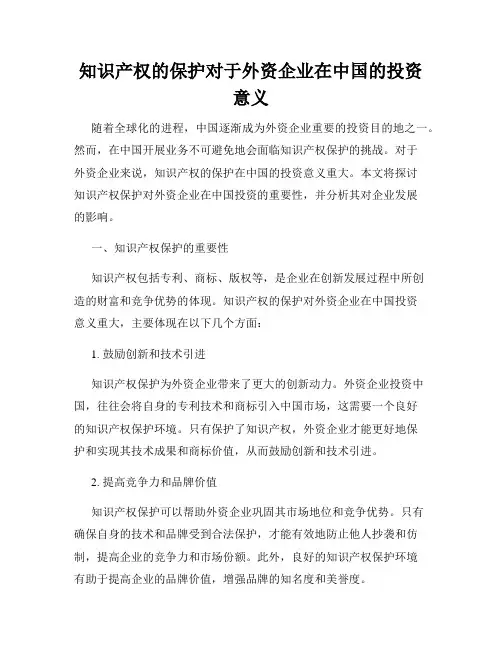
知识产权的保护对于外资企业在中国的投资意义随着全球化的进程,中国逐渐成为外资企业重要的投资目的地之一。
然而,在中国开展业务不可避免地会面临知识产权保护的挑战。
对于外资企业来说,知识产权的保护在中国的投资意义重大。
本文将探讨知识产权保护对外资企业在中国投资的重要性,并分析其对企业发展的影响。
一、知识产权保护的重要性知识产权包括专利、商标、版权等,是企业在创新发展过程中所创造的财富和竞争优势的体现。
知识产权的保护对外资企业在中国投资意义重大,主要体现在以下几个方面:1. 鼓励创新和技术引进知识产权保护为外资企业带来了更大的创新动力。
外资企业投资中国,往往会将自身的专利技术和商标引入中国市场,这需要一个良好的知识产权保护环境。
只有保护了知识产权,外资企业才能更好地保护和实现其技术成果和商标价值,从而鼓励创新和技术引进。
2. 提高竞争力和品牌价值知识产权保护可以帮助外资企业巩固其市场地位和竞争优势。
只有确保自身的技术和品牌受到合法保护,才能有效地防止他人抄袭和仿制,提高企业的竞争力和市场份额。
此外,良好的知识产权保护环境有助于提高企业的品牌价值,增强品牌的知名度和美誉度。
3. 减少经济损失和风险知识产权的保护可以降低外资企业在中国经营过程中面临的经济损失和风险。
在一个良好的知识产权保护环境下,外资企业可以更好地保护自己的核心技术和商业秘密,避免被不正当手段获取或侵犯。
这有助于减少企业因技术泄露、商业间谍等问题而遭受的经济损失和风险。
二、知识产权保护对外资企业发展的影响知识产权保护对外资企业在中国的发展产生深远的影响,既有积极的一面,也有挑战和难点。
1. 积极的一面良好的知识产权保护环境有助于吸引更多的外资企业投资中国,进一步推动中国的经济发展。
外资企业在中国取得成功,促进了技术、管理和经验的交流与传播,对中国企业的发展起到了积极的推动作用。
此外,知识产权保护也有助于提升中国企业的创新意识和创新能力。
2. 挑战和难点尽管中国在知识产权保护方面取得了一定的进展,但仍面临一些挑战和难点。
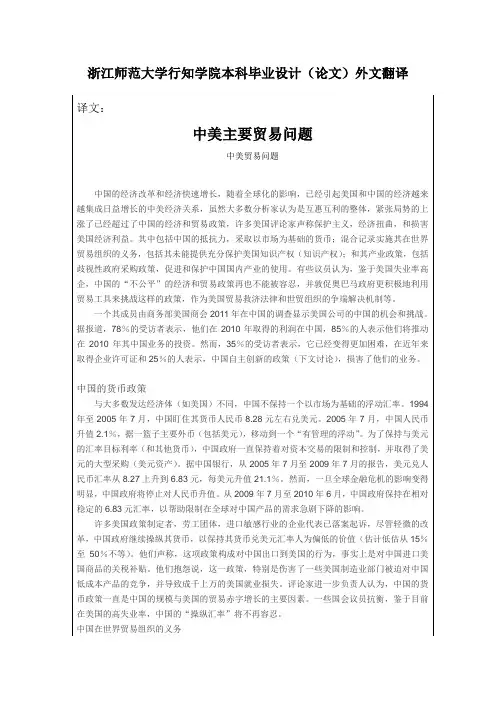
浙江师范大学行知学院本科毕业设计(论文)外文翻译译文:中美主要贸易问题中美贸易问题中国的经济改革和经济快速增长,随着全球化的影响,已经引起美国和中国的经济越来越集成日益增长的中美经济关系,虽然大多数分析家认为是互惠互利的整体,紧张局势的上涨了已经超过了中国的经济和贸易政策,许多美国评论家声称保护主义,经济扭曲,和损害美国经济利益。
其中包括中国的抵抗力,采取以市场为基础的货币;混合记录实施其在世界贸易组织的义务,包括其未能提供充分保护美国知识产权(知识产权);和其产业政策,包括歧视性政府采购政策,促进和保护中国国内产业的使用。
有些议员认为,鉴于美国失业率高企,中国的“不公平”的经济和贸易政策再也不能被容忍,并敦促奥巴马政府更积极地利用贸易工具来挑战这样的政策,作为美国贸易救济法律和世贸组织的争端解决机制等。
一个其成员由商务部美国商会2011年在中国的调查显示美国公司的中国的机会和挑战。
据报道,78%的受访者表示,他们在2010年取得的利润在中国,85%的人表示他们将推动在2010年其中国业务的投资。
然而,35%的受访者表示,它已经变得更加困难,在近年来取得企业许可证和25%的人表示,中国自主创新的政策(下文讨论),损害了他们的业务。
中国的货币政策与大多数发达经济体(如美国)不同,中国不保持一个以市场为基础的浮动汇率。
1994年至2005年7月,中国盯住其货币人民币8.28元左右兑美元。
2005年7月,中国人民币升值2.1%,据一篮子主要外币(包括美元),移动到一个“有管理的浮动”。
为了保持与美元的汇率目标利率(和其他货币),中国政府一直保持着对资本交易的限制和控制,并取得了美元的大型采购(美元资产)。
据中国银行,从2005年7月至2009年7月的报告,美元兑人民币汇率从8.27上升到6.83元,每美元升值21.1%。
然而,一旦全球金融危机的影响变得明显,中国政府将停止对人民币升值。
从2009年7月至2010年6月,中国政府保持在相对稳定的6.83元汇率,以帮助限制在全球对中国产品的需求急剧下降的影响。
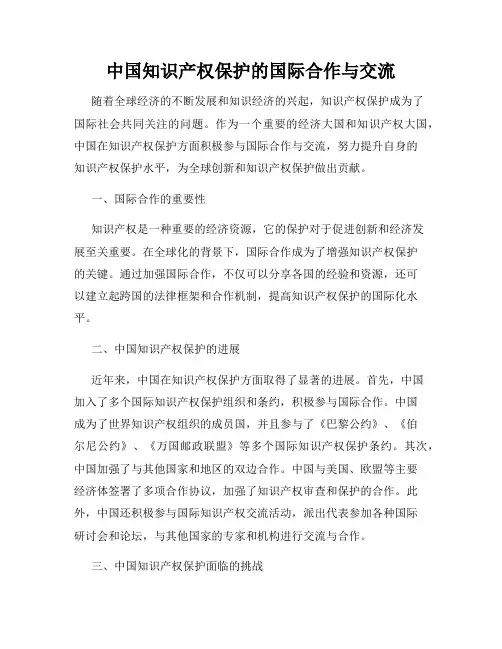
中国知识产权保护的国际合作与交流随着全球经济的不断发展和知识经济的兴起,知识产权保护成为了国际社会共同关注的问题。
作为一个重要的经济大国和知识产权大国,中国在知识产权保护方面积极参与国际合作与交流,努力提升自身的知识产权保护水平,为全球创新和知识产权保护做出贡献。
一、国际合作的重要性知识产权是一种重要的经济资源,它的保护对于促进创新和经济发展至关重要。
在全球化的背景下,国际合作成为了增强知识产权保护的关键。
通过加强国际合作,不仅可以分享各国的经验和资源,还可以建立起跨国的法律框架和合作机制,提高知识产权保护的国际化水平。
二、中国知识产权保护的进展近年来,中国在知识产权保护方面取得了显著的进展。
首先,中国加入了多个国际知识产权保护组织和条约,积极参与国际合作。
中国成为了世界知识产权组织的成员国,并且参与了《巴黎公约》、《伯尔尼公约》、《万国邮政联盟》等多个国际知识产权保护条约。
其次,中国加强了与其他国家和地区的双边合作。
中国与美国、欧盟等主要经济体签署了多项合作协议,加强了知识产权审查和保护的合作。
此外,中国还积极参与国际知识产权交流活动,派出代表参加各种国际研讨会和论坛,与其他国家的专家和机构进行交流与合作。
三、中国知识产权保护面临的挑战尽管中国在知识产权保护方面取得了进展,但仍然面临一些挑战。
首先,知识产权保护的法律体系和执行手段有待完善。
虽然中国已经出台了一系列知识产权相关的法律法规,但在实际执行中仍然存在一些问题。
其次,知识产权保护意识还不够普及。
一些企业和个人对知识产权保护的重要性认识不足,导致知识产权侵权问题频发。
此外,一些国家动力指数较高的产业和技术领域也成为了中国知识产权保护的难点。
四、未来的发展方向为了进一步提升中国的知识产权保护水平,我们需要继续加强国际合作与交流。
首先,我们可以加强与发达国家的合作,学习他们的经验和做法。
其次,我们可以加强与发展中国家的合作,共同应对知识产权保护面临的挑战。
外文翻译原文The Gravity Equation in International TradeMaterial Source: KELLY SCHOOL OF BUSINESS INDIANA UNIVERSITY Department of Business Economics and Public Policy Author: Michele FratianniAbstractThis chapter offers a selective survey of the gravity equation (GE) in international trade. This equation started in the Sixties as a purely empirical proposition to explain bilateral trade flows, without little or no theoretical underpinnings. At the end of the Seventies, the GE was “legitimized” by a series of theoretical articles that demonstrated that the basic GE form was consistent with various models of trade flows. Empirical applications of GE expanded to cover a variety of issues, such as the impact of regional trade agreements, national borders and currency unions on trade, as well as the use of the equation to sort out the relative merit of alternative trade theories. A new wave of studies is now concentrating on the general equilibrium properties of the GE and finer econometrics points. The renewed interest of the academic profession in the development of the GE is undoubtedly driven by the equation’s empirical success.Keywords: gravity equation, trade theories, borders, regional trade agreement, currency unions.JEL Classification: E58, F15, F33, G15Draft date: August, 2007I. INTRODUCTIONInternational economics and international business have common interests but somewhat different research agendas. The former emphasizes cross-border trade and capital flows, whereas the latter looks predominantly at foreign direct investment. Part of this difference results from the emphasis that scholars in international business place on the study of the multinational firm and part is due to intellectualspecialization. It is worth recalling that the yearly flows of international trade are a large multiple of the yearly flows of foreign direct investment, while the stock of foreign direct investment has only recently approached annual trade flows (see Figure 1). Furthermore, total real exports have grown faster, on average, than the world real GDP since the mid-1980s (see Figure 2). Finally, it is widely believed that exports are an engine of economic growth; see Krueger (2006). For all these reasons, international trade economists spend a great deal of time and resources understanding and explaining trade flows.With this brief background, I can state the objectives and outline of the chapter. The objective is to explain trade flows in terms of the gravity equation (GE). The reason for focusing on GE is two fold. The first is that GE, unlike other frameworks, has had great empirical success in explaining bilateral trade flows. For a long time, however, GE was a child without a father in the sense that it was thought to have no theoretical support. Since the late 1970s, this state of affairs has changed radically. Now, the gravity equation has strong theoretical support and can be derived from a variety of models of international trade. The second is that GE can be used to sort out alternative hypotheses of international trade.In its simplest form, the gravity equation (GE) explains flows of a good between pairs of countries in terms of the countries’ incomes, distance and a host of idiosyncratic factors--such as common border, common language, and common money-- that enhance or reduce bilateral trade flows:(1) 123ijk 0k k k k ik jk ij ijk M A Y Y d U ααα=,wheredenotes that the k good is exported by country i and imported by country j,andare expenditures on the k good by thetwo countries , and d is distance; A and αs are coefficients, and U is a well behaved error term. The vector of idiosyncratic factors has been omitted in (1) because these factors are more control variables than theoretically derived variables. Aggregating over all k goods, the GE of a given product can be transformed into a GE of total exports of country i:(2) 312ijk 0i j ij ij M A Y Y d U ααα=,where the k subscript has been suppressed and Y is the country’s income (forexample, nominal gross domestic product or GDP). The implications of GE –which we develop and discuss below-- are such that α1 and α2 are positive and in some instances equal t o one and that α3 is negative. Typically, equation (2) is specified in log linear form and estimated either with cross-section or panel data. In the latter case, a time subscript τ is added, except for the time -invariant physical distance:(3) 034ln()ln()ln()ijt jt ij ij ijt M Y d F u αααα=++++,Where in stands for the natural logarithm, 00ln()A α= and ln()ijt ijt u U =. The vector of idiosyncratic factors,, has also been added to equation (3). These factors are typically measured as dummy variables that acquire the value of one for the existence of the phenomenon and zero for its absence. The coefficients α1 through α3 are interpreted as elasticity’s or as percentage changes in bilateral trade for one percentage change in income and distance. The coeffic ient α4 is positive if the factor is trade enhancing (e.g., common language) and negative if trade reducing (e.g., terrorism).In the following section I will explore different models of international trade from which GE can be derived, ranging from models of complete specialization and identical consumers’ preferences (Anderson 1979; Bergstrand 1985; Deardorff 1998) to models of product differentiation in a regime of monopolistic competition (Helpman 1987) to hybrid models of different factor proportions and product differentiation (Bergstrand 1989; Evenett and Keller 2002) to models of incomplete specialization and trading costs (Haveman and Hummels 2004).II. TRADE THEORY AND THE GEComplete specializationSpecialization is at the heart of trade theory; it is complete or deepest when each country specializes in the production of its own output and consumers purchase the output of each country according to identical and homothetic preferences. Furthermore, trade occurs without friction, meaning that it is not impeded either by transport costs, tariffs or tariff-equivalent border obstacles. This idealized set-up serves the purpose of creating a benchmark of maximum trade flows. Each country imports and consumes a share of the goods produced by all other countries, as well as a share of its own output. These shares are the same for all countries. Consider, for example, two countries, country 1 and country 2, producing differentiatedproducts by country of origin. Country 1 will export its own good to country 2 in the amount of 1212M b Y =, where 1b =marginal propensity to import good 1 in country 2. Country 1 will also sell 12b Y amount of the good it produces to domestic consumers. Note that the propensity to consume good 1 is the same across all consumers regardless of location. Income of country 1 is the sum of purchases by consumers located in country 1 and consumers located in country 2, i.e., 111121w Y bY bY bY =+=, where w Y = world income = 12Y Y +. Thus, identical and homotheticpreferences imply that the propensity to import and consume good 1 is equal to country 1’s share of world income. Replacing 1b with 1/w Y Y , 1212/w M YY Y =. This is the simple GE derived by Anderson (1979, p. 108):译文国际贸易中的引力方程资料来源:印地安那大学凯莱商学院校刊 作者:米歇尔·弗拉蒂安尼摘要本文章精心选择并调查了在国际贸易中的重力方程(简称GE )。
国际投资法与中国对外投资在全球化和自由贸易的背景下,投资已成为各国之间经济联系的重要方式。
国际投资法是指各国政府为吸引外资而制定的一系列法律法规和条约,也是保护外国投资者在本国的投资利益和权益的重要法律框架。
而中国的对外投资也在近年来快速增加,成为了全球最大的对外投资国之一。
本文将探讨国际投资法对中国对外投资的影响,以及如何加强对外投资国的合法权益保护。
一、国际投资法对中国对外投资的影响国际投资法是保护外国投资者在本国的投资利益和权益的重要法律框架。
中国的对外投资也在快速增加,成为了全球最大的对外投资国之一。
在此背景下,国际投资法对中国对外投资的影响不容忽视。
首先,国际投资法规定了外国投资者在本国经营的权利和义务。
这些权利包括在本国境内行使与国有企业一样的权益、享有公平待遇、拥有完全投资自由和保护投资的随时被移除的权利等。
同时,外国投资者也有一定的义务,如必须遵守本国的法律法规、尊重当地社会文化、遵守所签署的协议等。
这些规定对中国的对外投资也是有着一定的影响。
其次,国际投资法规定了各国政府在批准外国投资时的义务和程序。
例如,在国际投资法中有一些强制的投资审查制度,当外国投资者拟在某个国家投资时,该国政府有权审查其投资拟议以及购买股份的意图。
这种制度对于中国出境投资者来说较为重要,因为它意味着中国投资者在海外进行投资时必须遵守当地政府的审查程序。
最后,国际投资法规定了外国投资者在面对投资框架变化时的维权途径。
当投资框架发生变化时,外国投资者有权利提出行为违规等措施向国际法庭提起诉讼。
这对于中国对外投资者来说也是非常重要的,因为该规定为中国投资者提供了一种应对外国政府的投资政策更改的途径。
二、加强对外投资国的合法权益保护中国已成为了全球最大的对外投资国之一,但在此过程中,也面临着各种投资风险。
因此,加强对外投资国的合法权益保护是非常重要的。
首先,中国应当积极参与制定国际投资法的标准和规范,在国际社会中发挥更大的影响力。
2016年一、简答题1、简述图像检索技术随着多媒体技术的迅猛发展,网络传输速度的提高,以及新的有效的图像/视频压缩技术的不断出现,对海量多媒体信息的需求日渐增强,在这一背景下,基于内容的多媒体信息检索技术应运而生。
它作为一种先进的检索技术,广泛地应用于多媒体数据库、知识产权保护、数字图书馆、远程医疗、天气预报以及军事指挥系统等。
它与传统数据库技术相结合,可以方便地实现海量多媒体数据的存储和管理;与网络搜索引擎技术相结合,可以用来检索互联网中丰富的多媒体信息,具有广阔的发展前景。
基于内容的多媒体检索技术具有与传统文本检索不同的特征,实施的是一种相似性检索,摒弃了传统的精确匹配,采用近似匹配或局部匹配的方法和技术逐步求精,来获得查询和检索的结果。
根据所检索媒体对象的不同,基于内容的多媒体检索技术又可分为基于内容的图像检索技术、基于内容的视频检索技术和基于内容的音频检索技术等。
基于内容特征的图像检索技术CBIR(Content-based Image Retrieval)主要依据图像固有的特征来标引和检索。
所谓图像特征包括:图像的画面内容特征,如图像颜色分布、纹理结构等;图像描述对象特征,如人、物、景等;图像的相关信息,如作者、时间、地点及其他物理特征;图像的移动和组合特征等。
基于内容的图像检索技术通过分析图像的内容,建立特征索引,并存储在特征库中。
用户在检索查询时,可以从图像自身的特征将查询需求描述出来,就可以在大容量图像库中找到所需的图像。
基于内容的图像检索技术包括的关键技术有颜色特征提取、纹理特征提取、形状特征提取、相关反馈等等。
目前比较成功的应用基于内容的图像检索技术的系统有IBM公司的QBIC系统、MIT媒体实验室的Photobook系统、新加坡国立大学的CORE系统等。
基于内容的图像检索方式主要有3种:(1)选择颜色的比例、轮廓形状以及纹理图案的图样进行查询。
例如用户可以给出红、绿、蓝三种颜色的百分比,或从系统所提供的图例中选择某个作为检索图样。
知识产权保护的国际比较研究第一章:引言随着全球化的进程不断推进,知识产权保护问题已成为国际社会关注的热点问题。
知识产权保护的国际比较研究,不仅能够了解不同国家的知识产权保护情况,更能够促进国际知识产权保护的合作和发展。
本文将围绕知识产权保护的国际比较研究展开探讨。
第二章:理论基础2.1 知识产权的概念知识产权是指人们在创造或发明过程中所获得的财产权利,包括专利、商标、著作权、工业设计、地理标志等。
知识产权是创新经济的核心,是创新活动中的重要要素之一。
2.2 知识产权保护的意义知识产权保护能够鼓励创新和发明,增强创新经济的竞争力;能够鼓励国际贸易和技术交流;能够促进经济发展和社会进步。
2.3 知识产权保护的国际法律框架国际知识产权保护的法律框架由国际条约、国际公约和国际惯例构成。
其中比较重要的大型国际条约包括《世界知识产权组织公约》、《巴黎公约》、《伯尔尼公约》、《里斯本协定》等。
第三章:国际知识产权保护的比较研究不同国家在知识产权保护方面的制度存在差异,下面将分别从专利保护、商标保护、著作权保护、地理标志保护、可租赁数字物品保护等方面展开比较研究。
3.1 专利保护美国是世界上获得专利数量最多的国家,其法律制度偏重于客观技术标准,发明人所提出的专利需符合一定的创新和非明显性标准。
欧洲和日本相对较为严格,其法律制度偏重于主观思想的发现和创意。
中国则较为注重实用性和新颖性。
3.2 商标保护美国的商标法比较宽松,商标注册时只需证明商标在本地区使用,且满足商业交易的需求。
欧洲和日本则相对更为严格,要求商标在本地区使用并注册之前进行实质性审查。
中国的商标法则从加强商标注册审核开始,注重打击商标侵权。
3.3 著作权保护在著作权保护方面,欧美国家的法律较为成熟,问题相对较少。
亚洲和非洲国家由于历史文化背景的差异,著作权保护方面存在一些问题。
3.4 地理标志保护地理标志保护是指对某一产品,基于其地理区域的或者由于该地区所拥有的特定制造技术和传统,对其生产制造和质量的监督和保护。
中文7870字附录A商标保护的各国比较摘要:商标保护的法律框架是指一个国家对商标保护目的、保护对象以及商标权利取得方式的基本安排。
在这一领域,由于历史及其他原因,世界各国商标保护的法律框架呈现出多样化的特征。
商标权利取得原则的类型,既有使用取得,也有注册取得,还有同时采用使用与注册取得;在采用注册制度的国家里,既有将注册商标和未注册商标统一在一个共同的保护伞之下的单轨制,也有以商标法保护注册商标、以竞争法或侵权法保护未注册商标的双轨制。
使用原则注重实体公正,保护使商标具有价值的主体的利益,注册原则侧重法律秩序的稳定性以及商标权的确定性。
各国或地区在商标保护的基本框架上,除了维持植根于自身法律传统中的原有制度以外,也互相汲取其他制度中体现公平性或者符合经济贸易发展趋势的做法。
关键词:商标;商标保护;法律框架;商标权;正当性商标保护的法律框架是指一个国家对商标保护目的、保护对象以及商标权利取得方式的基本安排。
在这一领域,由于历史及其他原因,不同法系的国家对这些基本问题有着各自不同的认识,形成了各具特色的商标保护的法律框架。
迄今为止,我们对商标法律保护的基本制度尚缺乏系统并具有理论深度的研究。
研究商标保护的法律框架及其相应的理论基础,有助于我们全面把握商标法律保护制度的基本面貌。
本文试以商标权利的形成制度为中心,以比较法为方法研究商标保护的法律框架,梳理当今世界上商标权利形成制度的各种类型,分析这些制度赖以产生的不同历史背景、法律传统及其理论基础,评价上述制度的利弊,并对商标保护法律框架的演变予以评论。
1 商标保护制度的基本结构当今世界各国的商标保护制度呈现出多样化的特征。
这种多样化既表现为商标权利取得原则的不同,又体现为在施行注册制度的国家里,再分化出“单轨制”与“双轨制”两种不同的保护模式。
因而,各个国家(与地区)之间表现出复杂多样的商标保护的法律框架。
“各种法律制度在限制保护与扩张保护的两极之间选取了不同的位置。
中文3180字毕业论文外文翻译题目:中国的知识产权保护与外国的直接投资中国的知识产权保护以及外国的直接投资提图斯.奥沃库斯在过去二十年里,中国的外商直接投资(FDI)量有着迅猛的增长。
虽然亚洲大部分外国直接投资流入到了发展中国家,其中中国占亚洲全球外国直接投资额几乎一半(见下图)。
中国的外国直接投资从1979年几乎没有增长至1998年的45.5亿美元,而在随后的不到十年,在2006年,其外国直接投资流入增加至695亿美元,其数量已经超过整个非洲大陆(355亿美元),但却远远落后于一个落后的拉丁美洲的总量(约合838亿美元)(见贸发会议,2007年)。
自1993年以来,中国已成为吸收外商直接投资最多的发展中国家和最受跨国公司欢迎的首选目的地,仅次于美国。
中国这么巨大和快速的的外商直接投资增量自然使人们提出一个问题:这么强大投资的背后动力是什么呢?中国是一个发展中国家,特别适合作为知识产权改革对外国直接投资流入的影响分析和的案例研究。
令人惊讶的是,中国在1985年以前没有知识产权保护。
然而,在1985年第一部专利法和在1992年和2000年大幅修订成立以来,中国经历了其专利制度的渐进改革。
于1992年,由于来自美国的压力,中国的专利法大幅修订,以适应许多工业国家的要求。
中国加强专利法律也是为了加速其加入世界贸易组织的步调,中国知识产权法律要求(如专利,版权和商标)也是为了更好的符合WTO的协议与贸易有关的知识产权(TRIPS)和其他主要的国际知识产权公约(Maskus,2004)。
自1992年以来,外国专利保持在19%的年平均增长率(见图2)。
大多数的中国专利(发明专利申请),由外国公司提出,如日本,美国,欧盟成员国,以及韩国等。
图2本文目的是为了探讨中国知识产权法律对其吸收外资的影响(1992∼2005)。
这篇文献的贡献在于有几个方面。
首先,这是第一个专注于大型和有影响力的经济发展,在过去二十年经历了其知识产权制度的显着变化的实证分析。
因此,这种分析提供了一个可以替代以往通常从一个主要工业化国家(如美国)家长的角度强调不同群体的主办国的外国直接投资流入的研究。
其次,我们还探讨知识产权保护对外商直接投资的效果可能会有所不同的伙伴国家的经济发展水平(史密斯,2001年)的可能性。
第三、从一个单一的一年的横截面数据为基础的研究,这项研究使用的38个国家,涵盖了更多的扩展时期(1992-2005)的数据,并允许考虑动态性质的外商直接投资与知识产权制度的政策变化。
第四,本文适用于其他知识产权作为知识产权制度的代理措施:作为每年衡量中国知识产权的保护强度。
知识产权指数,即使用前人研究的基础上,用打分的方法,经常被任意的选择上的重要性权重各种标准。
虽然在某些情况下很有效果,但是以知识产权指数为基础的研究措施,可能无法充分反映以书本为法律的专利法的修改和标准之间的相互间的动态影响作用,另外,随着时间的推移,对其他经济变量的影响(例如,外国直接投资)也不能很好地体现出来。
另外,我们使用实际数据,随着时间的推移原始国家的专利申请数量。
每年越来越多的外国专利申请可能是一个很好的指标,越来越多的外国公司在知识产权保护的法律和执法提供在中国的信心。
相对指数为基础的方法,这种跨越时间和措施,这一措施保护知识产权的强度变化占更多星移斗转、可能不易测量误差。
本研究的主要发现表明,中国知识产权保护的加强,导致在其外国直接投资流入的增加。
本文的实证结果进一步支持这一假设,加强专利法具有一定的市场扩张效果。
此外,我们的研究结果还表明,外商直接投资来自香港和台湾表现不同于源自其他高收入国家。
因此,本研究提供了关于当前有关政策改革在知识产权制度及技术转让同对中国贸易有何影响的相关实证。
知识产权保护和全球直接投资之间的联系并不明确,一直是大量的辩论和争议的来源。
更强的知识产权保护是否刺激或阻碍外国直接投资流向发展中国家的分歧依然存在。
根据一个国家的知识产权制度,通过几个选项之间进行选择:出口,外国直接投资,合资企业和许可,来为国外市场服务。
虽然一些理论研究表明,更强的知识产权保护能够促进创新,但是其对外国直接投资的影响既可以是积极也可以是消极的(Chin等,1988]和[赫尔普曼,1993])。
更强的知识产权保护可以减少因当地企业的模仿造成的威胁,从而确保外国公司直接投资的增加产生积极的影响和结果。
相比之下,如果加强知识产权保护,那么它在外国公司的垄断力量的增加可能会对外国直接投资产生负面影响。
当面对来自于本地生产的仿制品的竞争,跨国公司可能会尝试以最大限度地减少子公司的产量和销售利润的方式进行竞争(马库斯和本巴提1995],[史密斯,1999]和[史密斯,2001])。
此外,更强的知识产权保护也阻碍跨国公司选择增加外国直接投资,而不是许可。
相反,技术含量低的生产者,在沉重的知识型产业投资公司可能产生更敏感的知识产权保护问题(曼斯菲尔德,1995年],[马库森,2001年]和[夹克瑞克,2004])。
因此,保护知识产权和外国直接投资之间的关系仍然是一个经验性的尚未得到足够重视的问题。
近年来,有许多关于外国直接投资流入的影响因素的实证研究,如中欧和东欧国家和中国的经济转型。
以欧洲经济转型为重点的研究发现有助于吸引外国直接投资(卡斯特森和特拜耳传统因素(例如,市场潜力,生产要素成本和距离)和过渡的具体因素(例如,私有化和欧盟成员国的水平和方法),2004年,贝文和埃斯特林,2004年)。
相比之下,关注中国的实证研究将更加倾向于对基本经济因素,如市场规模,劳动力和投资成本的重视。
在重点研究了1978年至1992年进入中国的外国直接投资的驱动程序后,王和斯温(1995年)发现,GDP、工资和贸易限制措施都对外商直接投资具有积极的作用,而利率和汇率对外国直接投资却有着负面影响。
同样,海德和里斯(1996)通过研究对外国直接投资的54个中国城市中的位置决定的因素发现,外国直接投资主要是吸引中国有雄厚的工业基础和优良的基础设施的城市。
在另一项研究中,孙等人分析了整个中国的从1986年到1998年30个省的外国直接投资决定因素发现,外国直接投资的主要驱动力随着时间的推移改变。
萧(2004)在研究了中国为什么能够吸引这么多的外国直接投资后发现,中国的外国直接投资约50%来源于香港和台湾。
张(2005)问:为什么前往中国的外国直接投资的很大一部分来自于香港和台湾?研究发现,从主要发达国家(欧盟,美国和日本)的外国直接投资和香港、台湾不同。
此外,一些探讨了除中国外的外国直接投资的其他方面的研究和一些学者探讨的生产性投入对外商直接投资的影响,推动中国近期的经济增长(陈等人,1995年,吴,2000]和[姚明和伟,2007])。
虽然许多作者分析了各种经济因素外国直接投资的影响,但很少有研究知识产权的作用,因为在这项研究中所提倡的。
李和曼斯菲尔德(1996年)的创作是有关一个发展中国家的知识产权保护体系和美国的外国直接投资数量之间联系的第一个实证调查之一。
他们的经验证据表明,加强知识产权保护,对外国直接投资流入有积极的作用。
在最近的研究中,夹克瑞克(2004年),评价了知识产权在对东欧和前苏联的经济转型中外国直接投资吸引的积极作用。
该研究得出结论是,薄弱的知识产权保护对技术密集型行业的外商直接投资负面影响。
同样,奴凯姆和斯帕茨(2004)对知识产权的调查发现,外商直接投资联动使以东道国分类部门为数据的的外国直接投资有促进作用。
在中国,对知识产权在经济上的担任何种角色的分析比比皆是,但数据为根据的实证研究却寥寥无几。
近日,杜等人研究了区域经济、体制因素(即产权保护和合同执行)及美国跨国公司在区位选择上之间的关系,他建议美国跨国投资在有更好的知识产权保护的地区,以便减少政府对企业的干预,从而更好地执行合同。
然而,他们使用由每个省作为一个知识产权保护区域,从而代理政府批准的专利数量的决定可能会有问题。
虽然有可能在一些地区中经济发展水平和体制基础设施会有变化,但没有这样的变化就存在跨省的知识产权保护问题,因为中国有统一的国家知识产权法律。
统计推论强调,区域差异的影响会产生利用外商直接投资的知识产权保护知识产权代理变量时不改变跨区域的疑问。
附注:本文摘自《经济学学报》2010年6月第2期Intellectual property rights protection and the surge in FDI in ChinaTitus O. AwokuseChina has experienced a phenomenal surge in its inflow of foreign direct investment (FDI) in the past two decades. While Asia receives the bulk of FDI flows to the developing world, China accounts for almost half of Asia’s share of global FDI (see Table 1). China’s FDI grew from virtually nothing in 1979 to $45.5 billion in 1998; and less than a decade later in 2006, its FDI inflow increased to $69.5 billion. FDI flow into China accounts for more FDI than that of the entire African continent ($35.5 billion) and is just a bit behind all of Latin America ($83.8 billion) combined (see UNCTAD, 2007). Since 1993, it has become the largest recipient of FDI among developing countries and the most popular destination of choice for multinational firms, second only to the United States. This substantial volume and growth of FDI to China naturally raises the question: what is the driving force behind this growth?Among developing countries, China is particularly suitable as a case study for analyzing the impact of IPR reforms on FDI flows. Surprisingly, China had no IPR protection before 1985. However, since the establishment of its first patent law in 1985 and its substantial revision in 1992 and 2000, China has undergone a gradual reform of its patent systems. In 1992, mainly due to pressure from the United States, China’s patent law was substantially amended to make it more aligned with those of many industrial nations (Allison and Lin,1999). The strengthening of China’s patent laws was also accelerated by its membership in the WTO that required that Chinese IPR laws (i.e. patents, copyrights and trademarks) be better aligned with the WTO’s Agreement on Trade-Related Aspects of Intellectual Property Rights (TRIPS) and other major international IPR conventions (Maskus, 2004). Since 1992, foreign patents have increased steadily with an annual growth rate of 19% (see follow picture) of Chinese patents (invention patent applications) were filed by foreign firms with the most important patentees coming from Japan, the US, EU member countries, and South Korea.The objective of this paper is to investigate the impact of China’s IPR laws on its ability to attract FDI from 1992–2005. This paper contributes to the literature in several ways. First, this is the first empirical analysis focusing on a large and influential developing economy that has experienced significant changes in its IPR systems in the past two decades. Thus, this analysis provides an alternative to most previous studies that usually emphasize FDI flows from the perspective of a major industrialized parent-nation (e.g., United States) to a diverse group of host nations. Second, we also explore the possibility that the effect of IPR protection on FDI may vary by the level of economic development in partner countries (Smith, 2001). Third, in contrast to studies based on cross-sectional data from a single year, this study uses a panel data for 38 countries which covers a more extended time period (1992–2005) and allows for the consideration of the dynamic nature of the relationship between FDI and policy changes in IPR regimes. Fourth, this paper applies two alternative measures of IPR as a proxy for IPR regimes: Annual foreign patent applications as a measure of the strength of IPR protection in ChinaThe IPR index, used by most previous studies, is based on a scoring method that is often arbitrary in their choice of weights on the importance of various criteria. Although useful in some cases, the index-based measures of IPR, based on laws on the books, may not adequately capture the dynamic nature of the interaction between changes in patent lawsand standards over time as well as their potential impact on other economic variables (e.g., FDI). Alternatively, we use actual data on the number of patent applications from parent countries over time. The growing number of foreign patents filed each year could be a good indicator of growing confidence of foreign firms in the IPR protection laws and enforcement offered in China. Relative to the index-based approach, this measure of IPR protection strength accounts for more variation across time and may be less susceptible to measurement errors.The main finding from this study suggests that the strengthening of IPR protection in China led to an increase in its FDI inflows. This paper’s empirical results further support the hypothesis that the strengthening of patent laws has a market expansion effect. Furthermore, our results also show that FDI from Hong Kong and Taiwan behaves differently from the FDI originating from other high-income countries. Thus, this study provides much needed empirical evidence on the current debate regarding policy reforms in IPR regimes and its effects on technology transfer and trade with China.The nature of the linkages between IPR protection and global direct investment is ambiguous and has been a source of much debate and controversy. Disagreements persist on whether stronger IPR protection stimulates or discourages FDI flows to developing countries (for a review see Shatz et al. (2000)). Depending on a nation’s IPR regime, multinational firms can serve a foreign market by choosing among several options: exports, FDI, joint ventures and licensing. While some theoretical studies have shown that stronger IPR protection stimulates innovation, the effect on FDI could be either positive or negative ( [Chin et al., 1988] and [Helpman, 1993]). Stronger IPR protection could have a positive effect and result in an increase in FDI by reducing the threat of imitation by local firms and thereby ensuring high returns to the investment in research and development of foreign firms.In contrast, the strengthening of IPR protection may have a negative effect on FDI if it results in an increase in the monopoly power of foreign firms. When faced with less competition from locally produced imitation products, multinational firms may attempt to maximize profits by reducing affiliate output and sales ( [Maskus and Penubarti, 1995], [Smith, 1999] and [Smith, 2001]). Furthermore, stronger IPR protection could also discourage FDI if multinational firms choose to license instead of increasing FDI. In contrast to low-tech producers, firms investing in heavy knowledge-based industries may be more sensitive to IPR protection concerns ( [Mansfield, 1995], [Markusen, 2001] and [Javorcik, 2004]). Thus, the relationship between IPR protection and FDI remains an empirical question that has yet to receive adequate attention.In recent years, many empirical studies have examined the factors influencing FDI flows to transition economies such as Central and Eastern European Countries and China. The studies focusing on European transition economies usually found that traditional determinants (e.g., market potentials, factor costs, and distance) and transition-specific factors (e.g., levels and methods of privatization and EU membership) help to attract FDI ( [Carstensen and Toubal, 2004] and [Bevan and Estrin, 2004]). Comparatively, empirical studies focusing on China tend to place more emphasis on fundamental economic factors such as market size, labor and investment costs. In a study focusing on the drivers of FDI into China over 1978–1992, Wang and Swain (1995) found that GDP, wages, and trade restrictions have a positive effect while interest rates and exchange rates appear to have a negative effect on FDI. Similarly, Heid and Ries (1996) investigated the determinants of FDI location decision in 54 Chinese cities and found that FDI is mostly attracted to Chinese cities that have strong industrial base and excellent infrastructure.In another study, Sun et al. (2002) analyzed the determinants of FDI across China’s thirty provinces from 1986 to 1998 and found that the key drivers of FDI have changed over time. Hsiao and Hsiao (2004) also examined why China has attracted so much FDI and found that about 50% of China’s FDI originated in Hong Kong and Taiwan. Zhang (2005) asked why a very large portion of China-bound FDI comes from Hong Kong and Taiwan. They found that the characteristics of FDI from the major developed nations (EU, US, and Japan) are different from those of Hong Kong and Taiwan. Also, several studies have investigated other aspects of FDI in China. Some authors explored how FDI is a productive input spurring China’s recent economic growth ( [Chen et al., 1995], [Wu, 2000] and [Yao and Wei, 2007]).Although many authors have analyzed the effect of various economic determinants of FDI, very few have examined the role of IPR as advocated in this study. Lee and Mansfield (1996) authored one of the first empirical investigations of the possible linkage between a developing country’s IPR protection system and the volume and composition of US FDI in that country. Their empirical evidence indicates that the strengthening of IPR protection has a positive effect on FDI inflows. In a more recent study, Javorcik (2004) examined the effect of IPR on the composition of FDI for a group of transition economies in Eastern Europe and the former Soviet Union. The study concludes that weak IPR protection has a negative effect on FDI in technology-intensive sectors. Similarly, Nunnenkamp and Spatz (2004) investigated the IPR-FDI linkage using sectorally disaggregated FDI data for a large sample of host countries and found that stronger IPR protection played a positive role in attracting FDI.In China’s case, while qualitative analyzes on the role of IPR on its economy abound,data-driven empirical studies have been relatively scarce. Recently, Du et al. (2008) investigated the relationship between regional economic institutional factors (i.e., property rights protection and contract enforcement) and the locational choice of US multinational firms in China.1 Their results, based on a panel data set (1993–2001), suggest that US multinationals prefer investing in the regions that have better IPR protection, less government intervention in business, and better contract enforcement. However, their decision to use government-approved number of patents by each province as a proxy variable for regional IPR protection could be problematic. Although there may be some regional variations in the level of economic development and institutional infrastructures, no such variation exist for IPR protection across provinces since China has uniform national IPR laws.2 Thus, statistical inference emphasizing regional variations in the effect of IPR on FDI may be questionable when the IPR protection proxy variable does not vary across regions.。